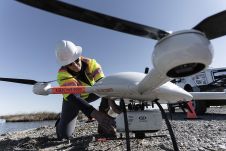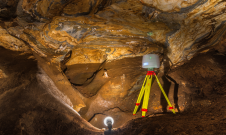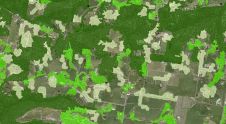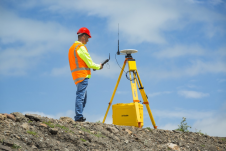尼日利亚需要联邦对其Geodata政策的承诺
188金宝搏特邀Gim国际采访Jide Kufoniyi
尼日利亚has all the prerequisites to install an effective national geospatial data infrastructure (NGDI) from which all its 170 million inhabitants would benefit. The country has many educated professionals, a national policy concept, money, lots of projects, more and more data, etc. But what is missing is the will to make a conscious effort to implement an NGDI in order to facilitate coordination of the geospatial resources and provide easy access to data such as Earth observation images. So says Jide Kufoniyi, president of the African Association of Remote Sensing of the Environment and member of Nigeria’s National Geospatial Data Infrastructure Committee, in this interview with GIM International.
尼日利亚空间数据基础架构的主要特征是什么?
In a nutshell, national geospatial data infrastructure (NGDI) implementation in the country has so far been largely characterised by unfulfilled expectations. We have a national geoinformation policy, adopted by the Minister of Science and Technology. We also have a 27-member NGDI Committee, together with six sub-committees (Geospatial Datasets, Standards, Clearinghouse and Metadata, Capacity Building and Awareness, Legal, Sustainability and Funding). The policy was submitted to the Federal Executive Council for approval in 2004, but it was subsequently returned for review of the membership of the NGDI Committee and the funding mechanism (since the proposed budgetary provision was 2.5% of the federal government’s total annual budget). Many years have passed since the draft was reviewed, but the modified version has still not been presented for approval by the federal government, let alone been processed for enactment by the National Assembly. It is obviously not regarded as a priority.
到目前为止,未能获得该政策的批准极大地影响了NGDI的可持续实施,因为首席机构 - 国家空间研发机构(NASRDA),无法真正支持足够的年度资金要求。尽管缺乏有能力的法律和资金,但Nasrda于2009年实施了一个试点项目,涉及其他三个NGDI节点机构:联邦测量师办公室,国家人口委员会和尼日利亚地质调查局。该项目成功,并展示了该国的NGDI准备就绪。我们使用国际标准为SDI开发提供低成本的国内解决方案,并使用土著专业人员进行了SDI飞行员的完整设计和实施。最终的Web门户基于ISO 19115,具有一个元数据搜索页面,可以找到四个代理机构的(限量)元数据,并包含一个可视化框架数据的网络地图视图。还有一个论坛来促进各个NGDI团体之间的沟通[www.ngdi.gov.ng]。
2011年,一项标题为“网络地图服务与当前尼日利亚NGDI门户网站的集成”的后续活动取得了有限的成功。不幸的是,从那时起,与NGDI实施有关的其他活动没有其他活动。尽管地球运动仍在启动和运行,但自2010年初以来,这四个机构都没有捕获额外的元数据记录。这显然强调了该计划可持续性的挑战。尼日利亚是一个拥有36个州的联邦国家,但其中只有一个是拉各斯州,迄今为止,他已经制定了自己的GI政策草案 - 一种对国家政策的驯化 - 另外两个州正计划这样做。
因此,“ NGDI火”仍在燃烧,尽管缓慢?
令人鼓舞的是,目前在许多政府和私营部门组织中有许多地理空间计划和绘制项目。对在各个级别上需要协调的SDI的需求的认识大大提高。除了通常需要足够的资金,我们还可以从战略职位上的一些SDI“冠军”中受益。
令人鼓舞的也是正在进行的土地改革计划,该计划旨在在全国范围内实现系统性的土地所有权和注册。它需要使用更快,相对较低的数据采集方法。同样,许多在联邦和州一级的测量和映射组织都将其生产方法和服务转变为完全数字化的,因此需要进行相关的教育。
18大学正在提供测量和地球信息学学士学位课程,而29个理工学院和四个专业机构正在提供普通和更高的国家文凭和研究生课程。尼日利亚的测量和地图社区认为有必要再次审查课程,以充分反映当今的地理空间技术,并且在大学和技术教育中负责质量保证的两个国家机构对他们的议程提出了这一建议。
尼日利亚is Africa’s biggest oil producer. Should there be less financial constraints there than in other African countries to support SDI projects?
Indeed, the oil wealth has contributed both positively and negatively to socio-economic development in the country, including in the area of SDI-related projects. To cite some examples, all of which are being executed without external funding or loans: Nigeria has launched three Earth observation (EO) satellites – NigeriaSat-1 (32m spatial resolution) in 2003, and NigeriaSat-X (22m resolution) and NigeriaSat-2 (2.5m PAN and 5m MX) in 2011 – as well as a communication satellite (NigComSat-1R). Moreover, many of the federation’s states have implemented mapping and GIS programmes. Cross River State carried out digital aerial mapping at 20cm ground sampling distance (GSD), resulting in the production of orthophotos of the entire state at 1:10,000 and five major towns at 1:2,000. Lagos State acquired digital aerial photography of the entire state at 10cm GSD and Lidar data to generate large-scale orthophotos/photomaps, a DTM and various layers of digital line maps as well as a web-based enterprise GIS. Osun State acquired aerial photography of the state at 25cm GSD for the production of a DTM, orthophotos/photomaps, various layers of line maps and a land information system. The Federal Capital Territory provided one-stop land information and geospatial services for government and citizens in the Abuja region. Many other states are planning or already executing similar projects. Furthermore, at the moment, there are about 21 continuously operating reference stations in various parts of the country.
Do the benefits outweigh the costs of the three Nigerian Earth observation satellites?
In terms of costs, many Nigerians believe that it is money well-spent. Meanwhile, the utilisation of the products of these satellites can only bring benefits to Nigeria. The 2.5m PAN and 5m MX images of NigeriaSat-2 are appropriate for implementation within many applications and infrastructure development projects, including agricultural production, urban renewal, water resource management, mitigation of various hazards such as desert encroachment and erosion, oil spills, etc. In particular, with only 200,000km of various categories of roads within the country’s 923,768km2of territory, the images would be very useful in the design and construction of new roads and maintenance of the existing ones.
尽管尼日利亚是世界上第26大经济体,但该国在贫困范围内的表现不佳:61%的尼日利亚人生活在绝对贫困中,其中90%的人每天不到一美元的生活。它是非洲大陆上人口最多的国家:到2015年,有1.88亿居民。一半的人口居住在城市地区,鉴于城市化的速度为3.75%,预计城市土地上的压力会增加,其随之而来的对其有影响风险。这是该国EO图像可以扮演关键角色的另一个领域。我关心的是难以获取图像。它们不容易获得。
There is tremendous growth in mobile communication, but the density of ICT facilities is still low. In 2012, 95% of Nigerians lacked access to computers and the internet, and the bandwidth is often still too low to support geographical information transfer. The launch of our telecom satellite came with the hope that its services would improve this situation but it has made no evident contribution so far.
每年数百名受过高等教育的测量师通过考试。那太多或太少了吗?
It is true that the universities, polytechnics and specialised institutions produce about 500 new highly educated surveying professionals of different cadres every year. The Surveyors Council of Nigeria has 2,344 people on its register, either in private practice or paid employment, although that number includes deceased surveyors. However, there are many more surveying and geoinformatics graduates from universities and polytechnics who are not registered but are nonetheless working in appropriate jobs. In addition many other departments, such as geography, are producing postgraduate-level application-oriented GIS professionals. Taking these different categories together, it could be tempting to say that there is little cause for concern in terms of manpower. However, when we consider the need to produce, manage and disseminate adequate, fit-for-purpose and easily accessible geospatial data for various national development programmes, it is evident that the number is grossly inadequate for such a large country as Nigeria.
The country has about 4,000km of international land boundaries and about 22,000km of interstate boundaries, not to mention its maritime boundaries. Most of these boundaries are yet to be fully demarcated and surveyed. Furthermore, according to the Presidential Technical Committee on Land Reform, most of the country’s states have issued fewer than 10,000 Certificates of Occupancy, and the process (including the cadastral survey) often takes a minimum of six months from the date of application. It is not unusual for an entire state to have fewer than five qualified surveyors in its employment, many of whom require retraining to cope with modern technology.
You are also president of the African Association of Remote Sensing of the Environment (AARSE). What difference is AARSE making for the continent?
自1992年以来,该协会在非洲的地球观察和地球空间技术的整体发展和吸收中一直发挥了谦虚而重要的作用。我们参加了许多计划和伙伴关系。Aarse非常积极地开发了实施Afrigeoss倡议的框架,这是非洲实现全球地球系统(GEOSS)计划的实现。作为地理信息的非执行工作组成员[参见2014年9月发行的第14页188金宝搏特邀, Ed.], AARSE contributes to various pan-African initiatives including the ‘Mapping Africa for Africa’, the ‘African Reference Frame’ and the ‘Global Geospatial Information Management’ programmes.
为了进一步为我们的运营领域的知识做出贡献,我们出版了期刊的书籍,专着和特别版,以及我们每两年在地球观察和地理空间信息科学上组织一次的大型国际会议的编辑程序。这些会议的声明无疑有助于改变,例如非洲资源管理卫星(ARM)星座计划的发展。
What do you expect from that satellite constellation programme?
自从阿尔及利亚,尼日利亚和南非发射EO卫星以来,该大陆的地理空间信息的意识和吸收都在增加。通过实施联合计划,对区域合作的巨大机会(尽管国家政策和优先事项不同)的认可对制定武器星座计划的制定有用。这得到了尼日利亚,南非,肯尼亚和阿尔及利亚的支持,并将很快欢迎其他非洲国家加入。我们的期望是该计划将有助于开发和传输卫星技术。非洲人力资源将通过共同参与和知识共享增长。该地区将获得快速,不受限制且负担得起的卫星数据,从而确保有效的土著资源管理:非洲,非洲。
利益相关者强烈主张该计划应成为非洲联盟委员会正在完成的非洲太空政策和计划的主要重点。但是,如果可以建立以非洲航天局形式的协调机构,则可以更好地实现区域空间计划。然后,我们将拥有一个有效的平台来实施武器和其他未来的非洲卫星。
Biography
教授Jide Kufoniyi是尼日利亚Obafemi Awolowo大学的地球信息学教授(地理系遥感和GIS计划)。除其他职能外,他是尼日利亚国家地理空间数据基础设施委员会的成员,非洲环境遥感协会现任主席和尼日利亚测量师研究员。他获得了尼日利亚测量的地理和研究生文凭(PGD)的理学学士学位,并在荷兰获得了摄影测量法和摄影法和博士学位的PGD和MSC。

























